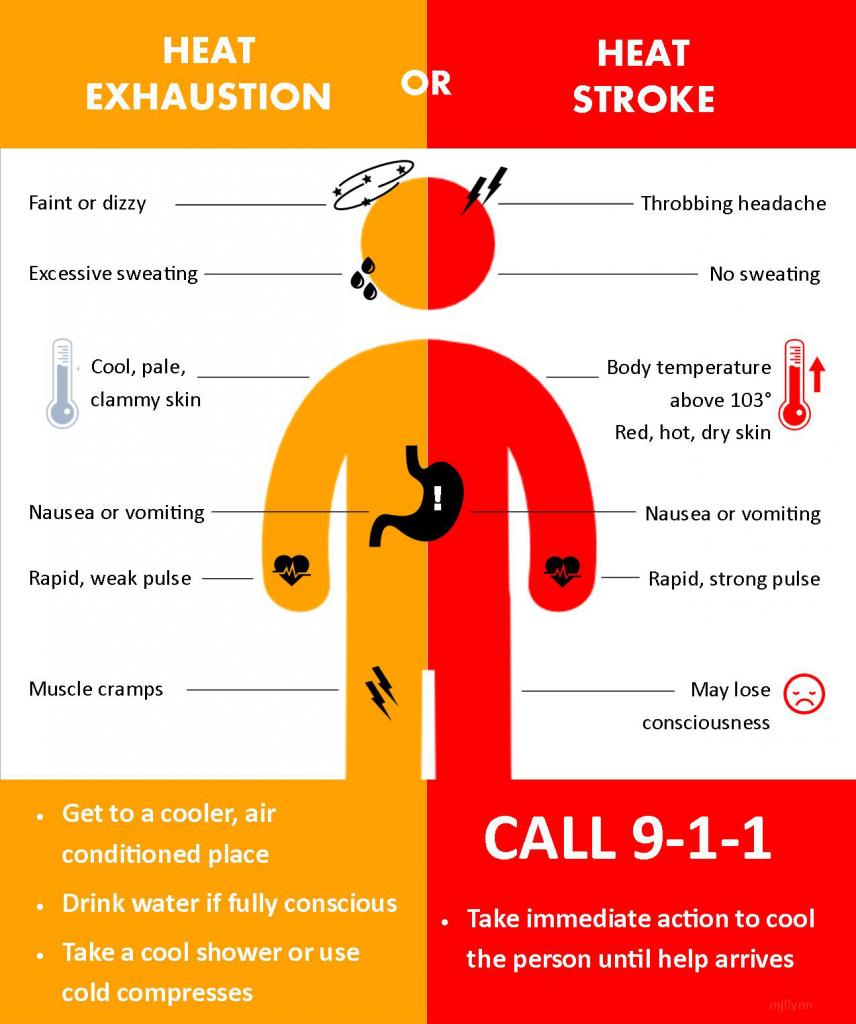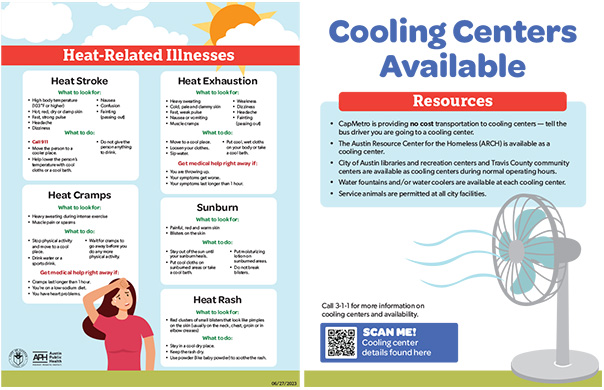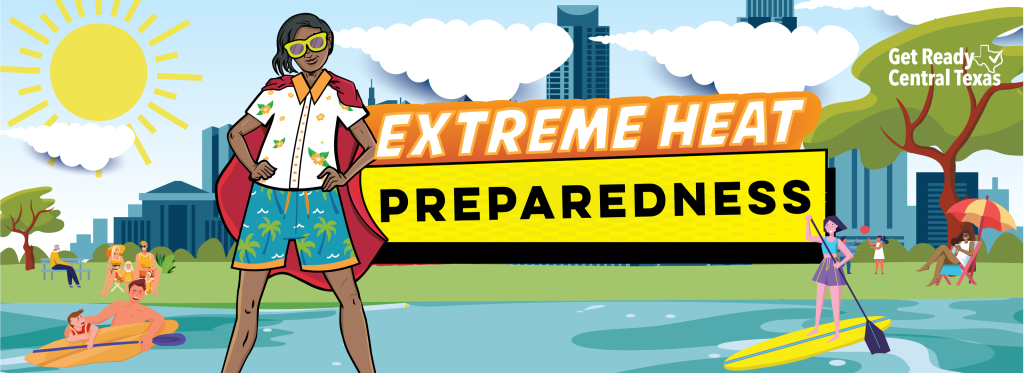Prepare for Heat & Summer Safety
The City of Austin encourages you to prepare for summer heat and enjoy summer safely. Help you and your loved ones stay safe in the heat and the water by doing your part to prepare!
Here are some essential emergency preparedness tips for summer heat:
- Make a plan: Create an emergency plan with your family that includes designated meeting spots and emergency contacts. Make sure everyone knows what to do and practice your plan.
- Build an emergency kit: Prepare an emergency kit with essentials such as non-perishable food, water, a flashlight, first-aid supplies, and any necessary medications. Do not forget to include supplies for pets.
- Know Your Neighbors: By knowing your neighbors and building a strong network, you can increase your community's readiness level in an emergency.
- Stay informed: Keep your cell phone charged or a battery-powered radio to monitor local weather conditions. Sign up for emergency notifications from WarnCentralTexas.org to receive important information during emergencies.
- Heat Safety Tips
-
Heat Safety
Look before you lock - Ensure children and pets are not left in hot, unattended vehicles
Stay hydrated - Drink more water than usual and avoid sugary, caffeinated beverages
Dress for the weather - Wear lightweight, light-colored, loose-fitting clothing
Protect your skin - Apply sunscreen with at least SPF 15
Stay out of the sun when possible - Find shade and wear a wide-brimmed hat when outdoors
Work and play safely - Avoid high-energy activities and exercise during extreme heat, especially during the afternoon
Protect your pets - Provide your pets with plenty of water and shade
Check in on elderly family members, friends and neighbors - Make sure they have access to air conditioners and/or fans and clean water for hydration
- Vulnerable Populations
-
Everyone is vulnerable to heat-related illnesses. But some community members are particularly vulnerable. Infants, children, older adults, outdoor workers, people who are pregnant, athletes, and people with chronic medical conditions have a higher risk for heat-related illness.
- Infants and Children: Young children and infants’ bodies are limited in how well they can cool themselves.
- Older Adults: Older adults are vulnerable to heat, especially if they have additional health issues, take medications, live alone, or have limited mobility.
- Chronic Medical Conditions: People with chronic conditions are more likely to have a serious health problem during a heat wave.
- People who Work, Exercise or Play Outside: Community members with outdoor jobs, or who exercise or spend time outside, make up a large percentage of heat-related illnesses.
- People who are Pregnant: Extreme heat events are associated with adverse effects including low birth weight, pre-term birth, and infant mortality.
For these community members, it is vital to know the signs of heat illnesses; wear light-colored, loose-fitting clothing; take shade breaks regularly; and check on family, friends, neighbors, and coworkers, and make sure they have what they need to stay cool.
- Know Signs of Heat-Related Illness
-
Heat Related Illness
Heat can be dangerous when you least expect it. Watch for signs of heat illness when you are working or playing outside.
Infants, children, older adults, outdoor workers, athletes, and people with chronic medical conditions have a higher risk for heat-related illness. Refer to more heat safety tips from the Centers for Disease Control and Prevention.
Heat Cramps Heat Exhaustion Heat Stroke Signs: Heavy sweating during intense exercise; muscle pains or spasms in the stomach, arms or legs Signs: Faint or dizzy; excessive sweating; cool, pale, clammy skin; nausea or vomiting; rapid, weak pulse, muscle cramps; heavy sweating, tiredness or weakness; headache; fainting Signs: Throbbing headache; no sweating; red, hot, dry, skin; nausea or vomiting; rapid strong pulse, dizziness, confusion, unconsciousness; body temp 103˚or higher Actions: Stop physical activity; drink water; wait for cramps to go away before you do any more physical activity; move to a cooler location. If cramps last longer than one hour, the person is on a low-sodium diet and/or the person has heart problems, call 911. Actions: Move the person to a cooler location to sip water if fully conscious, loosen clothing, take a cool bath/shower or use cold compresses. If symptoms last longer than one hour or worsen, call 911. Actions: Call 911.Take immediate action to cool the person until help arrives. 
- Heat Illness Statistics 2025
-
Year-to-Date Statistics
Covering: May 1–June 30, 2025
Of the 241 heat-related ED (emergency department) visits since May 1st, 768% of the ED visits at Hays, Travis, and Williamson County hospitals are male. Travis County residents make up 48% of the ED visits.
Prior reports were covering Travis County hospitals only, which does not represent the whole of the Austin Metropolitan area due to locations of hospitals and city/county boundaries. This report now includes all hospitals within Hays, Travis, and Williamson Counties to better illustrate the impact of heat in the community and compare with previous years' data. Although there are larger numbers of HRI ED visits reported, ratios and rates are still comparable between data sets.
The primary data source for emergency department (ED) data are Austin Metro Area hospitals (Hays, Travis, Williamson Counties). Data is obtained using both chief complaint and discharge diagnosis fields. Counts of ED visits are considered suspect or pre-diagnostic and do not necessarily represent the final diagnosis by a physician.Last updated: July 9, 2025
- Cooling Center Locations
-
Cooling Centers
Parks and Library facilities can be used as Cooling Centers during normal operating hours. A Cooling Center is a place for temporary reprieve from the heat. A Cooling Center is not an overnight shelter. Service animals are allowed in City facilities, including Cooling Centers.
Cooling Center details in 14 languages.
- Water Safety - Children and Drowning Prevention
-
Water Safety Tips
Summer is in full effect and water activities are a great way to cool down and have fun. Water activities come with safety concerns, and water enthusiasts should take precautionary measures to keep themselves and loved ones out of danger.
Children and Swimming Safety. Provide active and constant supervision of children in the water and be a water watcher. Put away phones and other distractions around water. Focus on swimming safety. When in any type of water, toddlers and infants should always be no more than arm’s length away from their parent or caregiver. Teach children to swim and learn to swim yourself.
Five essential water safety skills include being able to:
- Step or jump into water over one’s head and return to the surface.
- Tread water for one minute.
- Turn around in a full circle and find an exit from the pool.
- Swim 25 yards to exit the water.
- Exit the water on your own.
- If in a pool, exit without using the ladder.
Children should always wear a U.S. Coast Guard-approved life jacket when on a boat, around open bodies of water, and around docks. The life jacket should fit snugly and should not be able to be lifted above the ears. Learn where to get a loaner life jacket.
Learn CPR and basic water rescue skills so you are prepared in case of an emergency. Teach children to ask permission to go near water. Teach children to stay away from pool and spa drains.
Practice pool safety. Use physical barriers to prevent children from accessing any source of water. Set alarms on pools and doors/windows leading to pools. Make sure children stay away from water hazards in your community such as garden ponds, creeks and streams, wells, and cisterns, and other bodies of water. Teach kids that swimming in open water is different than swimming in a pool. Limited visibility, sudden drop-offs, uneven surfaces, currents and undertow can be dangerous. Do not use foam or air-filled toys (e.g. floaties, water wings, inner tubes, noodles) in place of a U.S. Coast Guard approved life jacket. Empty tubs, buckets and kiddie pools immediately after use. This also helps minimize mosquitoes. Watch for signs of water injury even when the swimming is over. Never leave a young child unattended in a bathtub. Do not trust a child's life to another child or to aides that help a child sit upright in a tub. Use safety locks on toilets and keep bathroom doors closed and toilet-bowl covers down when small children are in the home.
Drowning Safety. The most severe and most feared water emergency is drowning. Drowning may not always look like someone in obvious distress. It can be fast and silent with very little splashing, waving, or yelling. Respond quickly when you notice someone displaying the following uncontrolled signs:
- Head low in the water, mouth at water level
- Head tilted back with mouth open
- Eyes glassy and empty, unable to focus
- No response when you ask if they’re ‘OK’
- Eyes closed
- Hair over forehead or eyes
- Not using legs – Vertical
- Hyperventilating or gasping
- Trying to swim in a particular direction but not making progress
- Trying to roll over on the back
- Appear to be climbing an invisible ladder
For more water safety tips and drowning prevention information, visit Colin's Hope.
- Water Safety - Pools and Open Water
-
Swimming Pools and Open Bodies of Water Safety Tips from Austin Travis County EMS
There are additional precautionary measures one should take that are specific to this type of body of water. Water enthusiasts should be aware of the different safety hazards and prepare accordingly.
Swimming Pools. In addition to the above safety tips, observe the following safety tips specific to swimming pools:
- Swim in designated areas supervised by lifeguards and always obey pool rules.
- Be aware of depth markers before jumping or diving in.
- NO running in the pool area.
- Only dive off the diving board, never off the side.
- Also ensure the landing area is clear of other swimmers before diving in.
- Keep pool area secure with appropriate barriers/fences when not in use.
- Have appropriate, easily accessible rescue equipment.
- Consider a lightning detection alert system for your pool.
The American Red Cross recommends enrollment in home pool safety, water safety, first aid and CPR/AED courses to learn how to prevent and respond to emergencies.
Lakes, Rivers, and Other Open Bodies of Water. There are some special considerations to be taken when swimming in open bodies of water as swimmers often must share the lake with wildlife, boaters and other recreational water vehicles. In addition to the above safety tips, observe the following safety tips specific to open bodies of water:
- Know your location and, if on a boat, be able to give a description of the boat you are on in case of an emergency.
- Know how many people are in your group and perform periodic headcounts to ensure all guests are accounted for.
- If someone is missing, know where the person was last seen and what he/she was wearing.
- Protect your feet from jagged rocks, broken glass, or other sharp objects by wearing water shoes.
Boat Safety and Carbon Monoxide (CO) Emissions. Boaters should refrain from idling the motor for extended periods of time. Swimmers should stay away from exhaust vent areas and avoid swimming near or under the swim platform or back deck. Carbon monoxide is colorless, odorless, and tasteless. The CO emitted from boating traffic can pose a serious threat to boaters and swimmers.
Early symptoms of CO poisoning are:
- headache
- nausea
- weakness
- irritated eyes
- dizziness.
These symptoms are often confused with intoxication or motion sickness.
Bacteria. Refrain from swimming after flooding or heavy rains. Unlike swimming pools, natural waters are not chlorinated or disinfected. The risk of bacterial infection increases after heavy rains due to hazardous matter washing into the lakes and streams.
Water Depth Visibility. Do not jump or dive into the water if you are uncertain of the depth of the water. It can be difficult to determine how deep the water is and jumping into shallow water can cause serious injury or death.
Reptiles, Insects, and Other Critters. Stay away from wildlife. Swimmers share the water with many animals, reptiles, insects, and other critters. The number of occupants increases after heavy rains and flooding. It is best to refrain from swimming in lakes and rivers after major rains and flooding.
- Mosquito Protection Tips
-
Mosquito Protection Tips from Austin Public Health
Summer heat also brings an increase in mosquitoes. Mosquitoes may harbor several diseases that contribute to outbreaks of Zika, West Nile, dengue fever, encephalitis, and canine heartworm. Austin-Travis County is officially in mosquito season.
Effective mosquito control helps to control mosquito populations to prevent or reduce these outbreaks and enhances the enjoyment of outdoor activities by everyone in the community.
Here are a few things you can do to protect yourself from mosquitoes.
Drain standing water. Mosquitoes grow in standing water. They breed fast – in just a few days, they can lay hundreds of eggs. Once a week, empty and scrub, turn over, cover, or throw out containers that hold water, including tires, pet water bowls, containers and buckets, toys, birdbaths, planters, flowerpot saucers, trash containers, and rain barrels.
Protect yourself by applying insect repellent. Use Environmental Protection Agency (EPA)-registered insect repellents with one of the active ingredients below. When used as directed, EPA-registered insect repellents are proven to be safe and effective, even for individuals who are pregnant or breastfeeding. Repellents include DEET, picaridin (known as KBR 3023 and icaridin outside the US), IR3535, oil of lemon eucalyptus (OLE), para-menthane-diol (PMD), and 2-undecanone.
Find the right insect repellent for you by using the EPA’s search tool.
Wear protective clothing. Wear long pants and long sleeves when you’re outside, especially in places with high mosquito activity.
To report a mosquito problem, call 3-1-1 or complete a Service Request online.
- Downloadable Flyers
-
Heat Safety Flyer: English

Heat Safety Flyer: Spanish
Heat Safety Flyer: English.Water Safety Flyer English






